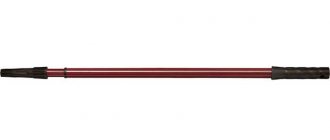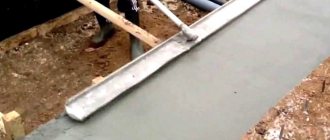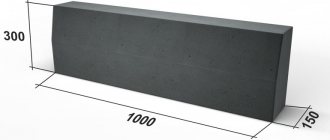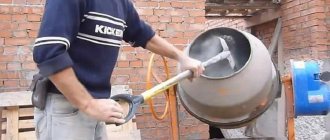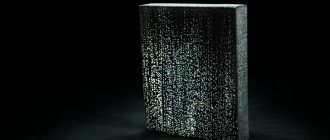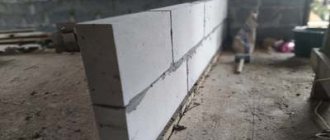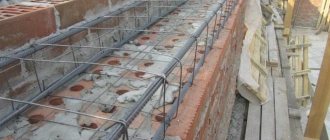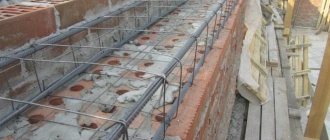Lightweight concrete is popular in private housing construction. This building material is used to build warm country cottages or to insulate finished residential buildings. This helps save natural energy resources, and the heating costs of the owners of such houses in winter are reduced.
On the left is porous concrete, on the right is concrete with porous filler.
Purpose of creating material
Lightweight concrete refers to all types of materials based on cement and other binders, which in an air-dry state weigh less than 1600 kg/m³. This figure is much lower than that of traditional concrete, which weighs about 2000 kg/m³.
Lightweight concrete blocks are lightweight
Important! Lightweight concretes are characterized by an increased degree of thermal energy retention, since they are porous and their thermal conductivity is significantly reduced. The reason is that the air filling the pores of materials is a poor conductor of heat.
About the concept of thermal conductivity
All solid, liquid and gaseous substances have thermal conductivity. Energy from a heated area is transferred to a colder area by chaotically moving particles - molecules, atoms, electrons. The closer to each other they are located, the more active the heat exchange occurs.
The density of a material directly affects its ability to conduct heat. For example, brick is denser than cellular concrete and conducts thermal energy better. A brick wall 500 mm thick also protects the room from heat loss, like a lightweight concrete wall 300 mm thick. Reinforced concrete is three times denser than expanded clay concrete, and accordingly, it is more heat permeable.
Concrete is a complex heterogeneous structure. The components included have different heat transfer abilities. The air in the capillaries of the cement stone and microcavities inside the filler is the least. The more porous the material, the worse the transfer of thermal energy.
The natural connection between the type of filler and the thermal conductivity of concrete is confirmed by the experiments of materials scientists V. G. Dovzhik and A. Misnar. They found that the smaller the size of closed pores in the body of the monolith, the worse the heat transfer.
The third factor affecting thermal conductivity is humidity. Water conducts heat 20 times better than air. By filling the pores of concrete, it worsens the thermal insulation qualities. In winter, freezing of the moistened layer of the enclosing structure is possible.
Composition of lightweight concrete
To make concrete, simple or combined binders, fillers, water and various additives are used. Cement can be used as a binder:
- Portland;
- Slag Portland;
- pozzolanic;
- slag-lime.
Less active binders are also suitable for creating lightweight concrete, since during the technological process they will still acquire the desired properties. When producing high-quality concrete, be sure to use cement of the appropriate grade and quality.
Reducing the specific gravity of concrete becomes possible through the use of special lightweight aggregates:
- expanded clay;
- tuff;
- pumice;
- slag, etc.
Porous granulated slag.
Occasionally crushed brick stone is added to the composition, which is a fairly dense material and is required where high strength is important (for example, for pillars, walls of the first floor). A certain part of the light aggregate can be replaced by heavy types of raw materials - sand, gravel, crushed stone.
To preserve the finely porous structure of the concrete stone, aggregates are introduced in crushed form. Boiler slag is not suitable for the manufacture of reinforced concrete structures: its sulfur content quickly destroys the metal. It is preferable to use expanded clay or pumice, which are inert to iron.
Classification of concrete density kg/m3 by grade
Every type has a brand. This is what everyone who purchases cement needs to focus on. It consists of the letter M and the following number. In addition, there is another characteristic - class. This is usually indicated in regulatory documents, but when ordering, buyers often distinguish between concrete grades. The class is designated by the letter B, followed by numbers that show what load the frozen solution will withstand.
Common brands:
- M100 . It is used in the process of preparatory work before starting to pour the foundation. Used as a concrete base for curbs in road construction.
- M200. The most common brand. This solution belongs to the heavy class, with an average density of 2000 kg/m3 . Contains cement, gravel, sand. The optimal combination of strength, quality and price. Suitable for the foundation of residential buildings, landscaping work (construction of pedestrian paths, sidewalks), production of concrete pavements, stairs, slabs. This brand does not crack and withstands pressure and temperature changes well. This determines its popularity and versatility of use.
- M250 (class B 20). The properties are almost the same as the previous brand, but the strength is higher. Capable of forming high load slabs.
- M300. Suitable for monolithic foundations, walls, fences, flights of stairs.
- M350 (B25). High strength, used for monolithic structures in multi-story construction, as well as for load-bearing columns of buildings, foundations of swimming pools and airports.
The table below indicates which grade of concrete corresponds to a certain class in terms of average density.
Concrete density table kg/m3
| Class | Average strength, kgf/sq.cm. | Brand |
| AT 5 | 65 | M75 |
| B7.5 | 98 | M100 |
| AT 10 | 131 | M150 |
| B15 | 196 | M200 |
| IN 20 | 262 | M250 |
| B25 | 327 | M350 |
| B30 | 393 | M400 |
| B35 | 458 | M450 |
| B40 | 524 | M550 |
| B50 | 655 | M600 |
| B60 | 786 | M800 |
How to influence volumetric weight?
The density of a concrete monolith is largely determined by the characteristics of the components of the mixture. It is their selection that attention should be paid to in order to obtain the desired weight of concrete solution at the output. Moreover, the actual composition and ratios in the recipe are far from the only decisive factor.
More than half the mass of concrete is made up of coarse aggregate, so it is initially necessary to determine its own weight and even bulk density. The latter will show how many air pockets remain inside for sand and cement, but the mass of stones will make a much more serious difference. For example, if the composition of B25 includes granite or dolomite crushed stone with a strength of M600, its own density will be so high that the concrete will be no lower than D2200-2400. And pumice, expanded clay and tuff will give only a lightweight type of monolith no heavier than 1.6-1.8 t/m3.
In order to ultimately obtain concrete with the required values of density and strength, they always take cement of a higher grade - as a rule, by 2-3 grades (this difference in the solution will be “eaten up” by cheaper components such as sand and water).
The density of the cement monolith can be changed with the help of other components of the solution, but not so noticeably. For example, weight gain is caused by the use of fine aggregates. And don’t forget about special plasticizers that improve the fluidity of the mixture while simultaneously reducing the amount of liquid in it.
Main characteristics and requirements
When choosing a mixture for construction, take into account its compliance with the following requirements:
- mobility and ease of placement;
- sufficient strength;
- a certain volumetric weight;
- high frost resistance (for external structures);
- low hygroscopicity.
Testing concrete for strength
It is equally important to know the volumetric weight of lightweight concrete, which depends on its composition and type of fillers.
Important! Weight has a direct impact on thermal conductivity: the lighter the material, the better it maintains the temperature inside the room. For example, the lightest polystyrene concrete has a thermal conductivity of 0.055 W/mC and is usually used for thermal insulation of buildings.
Characteristics of building materials of this group:
- Strength. The indicator is determined by the quality of the binder, its consumption per 1 cubic meter of mixture, the degree of compaction, and the reliability of the fillers. Compressive strength (the pressure that the material can withstand) is divided into classes and is designated by the letter B with numbers. For lightweight concrete it is equal to B0.75-B. For example, with indicator B20, the material can withstand a pressure of 20 MPa, although in practice, when making calculations, a safety margin of 25% is required.
- Density. Depends on the consumption of binder, water and characteristics of the aggregate. Density varies widely (from 150 to 1800 kg/m³), but more often it is 800-1500 kg/m³ (with the exception of cellular concrete, the density of which is an order of magnitude lower).
- Hygroscopicity. Most types of lightweight concrete strongly absorb moisture. The leader in this issue is aerated concrete with a water absorption of 25%. The lowest rate was observed for polystyrene concrete – 5%.
- Frost resistance. To build external walls, you can use materials with frost resistance of 25 cycles (F25). This means that they will not lose strength after the specified number of freezing and thawing cycles. However, it is better to choose lightweight concrete with increased frost resistance (from F100-150). When constructing interior partitions or insulating walls inside buildings, there are no requirements for this indicator.
Brief overview of the main representatives of this type of concrete
Although the expanded clay concrete block is lightweight, it is also quite fragile, which is a significant disadvantage.
Concrete building materials of the light group include:
- expanded clay concrete;
- pumice concrete;
- vermiculite concrete;
- slag concrete;
- perlite concrete;
- expanded clay perlite concrete;
- agloporite concrete;
- slag pumice concrete;
- shungizite concrete;
- thermolite concrete;
- porous concrete with glassy fillers.
Expanded clay concrete
For the production of expanded clay concrete, cement, fine sand, special mortar fillers, and water are used. The filler can be expanded clay, gravel with a porous structure, or algoporite.
Advantages of expanded clay concrete:
- the only building material from the LB category that does not shrink;
- unlike other representatives of the group, dense expanded clay concrete is used for foundation construction;
- density reaches 2000 kg/cubic. m;
- thermal conductivity - 0.14-0.55 W*mS;
- frost resistance - 300 cycles;
- Expanded clay concrete blocks are lightweight.
The disadvantages include: hygroscopicity, fragility of the material and the complexity of its processing associated with abrasiveness.
Cellular concrete
The building material is in demand both among developers and manufacturers.
Frost-resistant block made of lightweight cellular concrete.
Building material options:
- aerated concrete;
- foam concrete;
- foam-gas concrete.
Concrete blocks differ in production technology (the method of forming pores in the building material), composition and quality indicators.
Advantages of cellular concrete:
- high density;
- fire resistance;
- frost resistance;
- increased ability to retain heat inside the building;
- the material can be produced at home;
- high vapor barrier and sound insulation;
- long service life;
- environmentally friendly.
Disadvantages: fragility, low resistance to tearing.
Polystyrene concrete and products made from it
In addition to sand, cement and water, this building material also contains polystyrene chips, which give concrete blocks increased thermal insulation properties. The maximum density of the material is 600 kg/m³.
These indicators determine the main area of application of the building material - insulation of residential buildings, under-roof spaces, engineering structures, for arranging floor screeds. But it is rarely used for external construction work or as a structural building material.
Differences between polystyrene concrete and other types of concrete:
- minimum weight of the product;
- absorbs less moisture;
- gives a slight drawdown;
- lowest cost.
Thermal insulating lightweight blocks made of sawdust concrete.
Sawdust concrete
Sawdust concrete, which has recently appeared on the building materials market, belongs to the light category of concrete building materials.
Its main difference is that the material contains wood shavings (sawdust), instead of which rice straws, hemp, and flax straw are sometimes used in the production of building materials.
The binding component is cement.
Characteristics of the building material:
- maximum density - 800 kg/m³;
- minimum thermal conductivity - 0.07 W*mS;
- the building material can be used as thermal insulation, structural and thermal insulation.
Advantages:
- non-flammable material, despite the fact that it contains wood;
- environmentally friendly;
- the material can be made at home.
The only downside is its high cost.
Silicate concrete
The main feature of the building material is the use of limestone, pre-mixed with a silica element, instead of cement.
As a result of a chemical reaction between these components, calcium hydrosilicate is formed, which influences the procedure for combining the mass of the solution with the filler. Additionally, silicate concrete contains plasticizers and pore formers.
Scope of application of silicate blocks:
- thermal insulation of residential buildings, engineering structures;
- construction of internal walls of buildings;
- arrangement of floor panels;
- construction of staircases.
Advantages:
- low price;
- high frost resistance;
- high density and strength;
- heat resistance;
- long period of operation.
Porous lightweight silicate concrete blocks.
The concept of ultra-light concrete
This is an artificial LB with a maximum density of 600 kg/m³, which is often used for sound protection and thermal insulation of buildings, and the construction of fences.
The density and weight of such blocks is reduced due to the formation of air-filled pores inside the material during the production process. Ultra-light concrete is characterized by a low thermal conductivity, so it is often used for insulation of residential buildings.
Filler options for building materials:
- Algoporite is a product of processing fuel waste and clay. This component resembles expanded clay gravel in its properties. Density - 400-600 kg/m³.
- Expanded clay is a product obtained by processing low-melting clay. Density - 300-500 kg/m³.
- Perlite. The density of the filler is 250-350 kg/m³.
The most popular of the ultra-light concrete grades presented on the construction market is the Sovbi brand building material.
Foam glass concrete also falls into this category. Its main difference is the type of filler, which is foam glass gravel. The material is often used for flooring and thermal insulation of buildings; block structures and slabs are made from it.
Pros and cons of the material
Lightweight concrete is very popular in construction because it has many positive properties and beneficial advantages:
- High thermal insulation characteristics. It is possible not to carry out additional insulation of the walls, thereby reducing their thickness and saving on materials.
- Soundproofing. Due to their porosity, lightweight concrete significantly reduces the level of noise entering the room.
- Small mass. Load-bearing walls and partitions will weigh less than those made from conventional heavy concrete. This will reduce the load on the foundation and make the structures simpler. In addition, lightweight blocks can be laid manually, without the use of special equipment.
- Plasticity, ease of processing. Lightweight concrete can be sawed, cut, and ground without problems, so it is even suitable for the manufacture of decorative products. Parts of the required size and shape can be made directly on the construction site.
- Tolerance of negative factors. Lightweight concrete tolerates changes in temperature and humidity well, and is not sensitive to mechanical stress and stress. Of course, dents may appear in the blocks, but their overall integrity will not be compromised.
- Environmental friendliness. Most types of lightweight concrete are prepared from safe, environmentally friendly ingredients. In addition, production waste can be used to create some of them, which has a positive effect on the environment.
- Self-cooking. Some concrete can be started at home without any problems, which reduces the overall cost of work.
The disadvantages of this group of building materials are also worth noting.
Important! To increase the reliability of load-bearing walls, they should be reinforced.
Due to the heterogeneity of the structure, some concrete may have an increased tendency to form small cracks, although such defects do not affect the service life of the building.
The disadvantages include the high moisture absorption of materials, so you should immediately take care of reliable waterproofing of surfaces. Otherwise, the thermal insulation properties of the blocks will decrease.
Due to the reduced density, fasteners may not adhere well to the walls, although this problem can be solved by using special anchors and installing mortgages. For interior finishing of walls made of lightweight concrete, it is necessary to perform high-quality preliminary priming. Exterior finishing is limited to applying plasters or installing a ventilated façade.
Production technology
To produce lightweight concrete, no specific knowledge or experience in working with such material is required. Therefore, making it at home is not difficult. All you need to prepare is the classic composition: water, sand, aggregate, cement. The usual proportions are considered to be: W (water) – 0.5, P (sand) – 2, W (aggregate) – 4, C (cement) – 1.
Table 1 - Ratio of proportions of structural elements depending on the grade of cement
| Brand | Ratio (H:R:W:C)* | For what purposes is it used? |
| 150 | 1:3,5:5,7:0,5 | paths on the street, floors in the house |
| 200 | 1:2,8:4,8:0,5 | foundations for garages, bathhouses, outbuildings |
| 300 | 1:1,9:3,7:0,5 | building walls, strip foundations |
| 400 | 1:1,2:2,7:0,5 | the most durable, can be used for any purpose |
*Portland cement equivalent to concrete grade is used
Tools used in work:
- concrete mixer for mixing the mixture;
- special vibrating table (for expanded clay concrete);
- installation for the production of foam concrete;
- block forms (for cinder blocks, bricks, foam blocks).
There are 2 ways to make lightweight concrete:
The natural way
Stages of work:
- mix the solution manually or using a concrete mixer;
- prepare appropriate forms (formwork);
- pour in the prepared mixture;
- keep it for 2.5 hours: the higher the grade of concrete, the less time it takes to set;
- remove the finished product by dismantling the formwork;
- dry the material, this takes 25-30 days.
Autoclave method
Quartz sand, Portland cement and lime are used as base materials. Aluminum dust is used to make aerated concrete.
Place the components of the mixture in an autoclave, where the components are kept under high temperature.
Under the influence of temperature, the mixture increases up to 80 percent, acquiring lightness, strength and high thermal insulation.
Heat and humidity steaming chambers
It is based on keeping the mixture in special containers under the influence of steam. Such lightweight concrete is much better, its characteristics are higher than those obtained by the first two methods, but the process is expensive to produce. Accelerated hardening occurs due to steam treatment of the product.
Stages of heat and moisture influence on the mixture:
- initial heating, which lasts from 2 to 5 hours;
- a gradual increase in temperature by 30°C per hour (duration is 2-3 hours);
- maintaining a constant level of 80°C (from 3 to 5 hours);
- Cooling lasts up to 3 hours.
Types of lightweight concrete
There is the following classification of lightweight concrete by structure:
- Ordinary. They are prepared from a mixture of binder, water, coarse and fine aggregates. They differ from standard heavy concrete by the presence of porous coarse aggregate instead of crushed stone. Air cavities in the composition occupy up to 6%.
- Lightweight, large-porous (sandless). Sand and crushed stone in such materials are replaced by fillers with large pores. There is no sand in the composition either. The amount of air voids has been increased to 25%.
- Cellular (porous). The composition contains additives that promote gas formation or form foam. No coarse filler is added.
Cellular foam concrete
According to their purpose, all lightweight concrete is divided into groups:
- structural - used to create structures that accept external loads;
- thermal insulation – suitable for thermal insulation, characterized by low thermal conductivity;
- structural and thermal insulation - used for the manufacture of structures that can resist loads and eliminate heat loss.
Concrete with porous fillers
Such materials are widely used in private housing construction and can serve as the basis for the walls of one-story buildings.
Expanded clay concrete
This building material contains cement, sand and expanded clay as filler. Air-entraining additives, for example, saponified tree resin, are also added to the mixture.
The specific gravity of expanded clay concrete is 300-600 kg/m³, it is practically not subject to shrinkage, suitable for arranging foundations, frost-resistant (up to 300 cycles), lightweight.
Important! Disadvantages include the ability to strongly absorb moisture and the difficulty of processing due to abrasiveness.
Agloporite concrete
The building material consists of processed clay mixture (agloporite), ash and slag waste from the coal industry. Most often it is used for the construction of low-rise structures and outbuildings, as it has a low compressive strength class - B2.5-B7.5.
Concrete with lightweight organic aggregates
Materials from this group contain a variety of organic substances as fillers.
Arbolit
The role of filler in wood concrete is played by wood crushed to the state of chips. Cement is used as a binder.
To reduce the negative impact of organic matter on the binder, a mineralizer (liquid glass, aluminum sulfate, calcium chloride) is also added. Wood concrete is well suited for the construction of low-rise buildings, utility structures, and enclosing structures.
Wood concrete blocks 250x300x500
Main characteristics:
- density – 400-850 kg/m³;
- water absorption during mixing – 50-80%;
- elasticity – 1000-2300 MPa;
- shrinkage – 0.5%;
- Frost resistance – up to 50 cycles.
Kostrobeton
The filler in fire concrete is crushed lignified hemp stems (bone), additives are lime, alumina sulfate, calcium chloride, binder is cement. The material does not rot, is not affected by insects, is not spoiled by rodents, has low thermal conductivity, and is very easy to process. It is usually used to create internal partitions, and also as insulation.
Polystyrene concrete
The composite material with this name is made on the basis of cement and polystyrene foam granules. It is suitable for filling space inside structures, insulating rooms and constructing buildings that do not experience serious loads.
Important! Polystyrene concrete has excellent heat-insulating and sound-proofing properties, is economical, safe, and is characterized by high frost resistance.
Polystyrene concrete block 600*400*200
Cellular concrete
The basis of cellular concrete is siliceous fillers, which during the reaction form oval or round voids inside the mass. Such building materials are produced using three different technologies:
- by processing in heat and humidity chambers;
- during natural hardening;
- as a result of autoclave hardening.
Foam concrete
Foam concrete is made from a cement-sand mixture, water and a foaming agent. Thanks to the latter, pores are formed in the structure of the building material. Foam concrete gains strength for a long time - 20-40 days after pouring, and in the next 2-3 years its characteristics only improve. It is used to build houses, insulate roofs, floors, and walls.
Insulation of walls with foam concrete
Aerated concrete
Finely dispersed aluminum acts as a gas generator in this material. It is introduced into the main composition of quartz sand, cement, water, lime mortar, after which the foaming reaction begins.
As a result, a mass is created with interconnected pores of round or oval shape up to 4 mm in size. Aerated concrete is well suited for all types of construction.
Aerated concrete AEROC Hard
Application of lightweight concrete
Structural concrete is suitable for integral laying of walls, creating wall panels, installing bridge piles, and restoring various structures. Panels made of coarse-cell concrete are suitable for the construction of large-block structures.
Very warm one-story houses are made from fine-mesh materials that are not afraid of fires. Some types of materials are suitable for thermal insulation of pipes and furnaces.
Lightweight concrete products
Building materials are used for the production of various products:
- solid and hollow small and medium blocks up to 30 kg for walls;
- liner stones for floors;
- large blocks (77-154 cm or more);
- blocks with finished plaster;
- lightweight multilayer blocks made of different materials.
Lightweight concrete is an excellent material for construction and insulation of buildings. With its help, you can reduce the weight of finished structures, lighten the load on the foundation and extend the maintenance-free service life of buildings.
Scope and features of application
The characteristics of this variety allow you to: Construct lightweight structures, including reinforced walls and ceilings. To strengthen them, ordinary metal rods, beams, channels, reinforced belts, columns and crossbars from heavier building mixtures are selected. The maximum energy saving effect is observed when laying elements that separate different temperature zones: external walls, floors of the first and last floors. Use the material as industrial insulation: ensuring minimal load on the foundation, concrete can withstand high temperatures well and is not afraid of exposure to aggressive environments. Produce masonry products: blocks, panels, floor elements. Lay spans, trusses and roadway slabs of bridges subject to their stressed reinforcement. Carry out restoration work, including repair of tunnels, large-block apartment buildings, columns and bridges.
Lay and line furnaces (for heat-resistant mortars). In most cases, blocks made from lightweight grades are easy to process and cut, and there are no problems when finishing them. A limitation of its use is its high water absorption capacity; under normal conditions, this material is not suitable for the construction of foundations and underground structures. Exceptions are compounds with hydrophobic additives that have a waterproof rating of W4 and higher. Blocks made of such concrete, used for the construction of external systems, need to be protected from external influences; the easiest way to do this is with plaster. Production technology, nuances of do-it-yourself kneading
